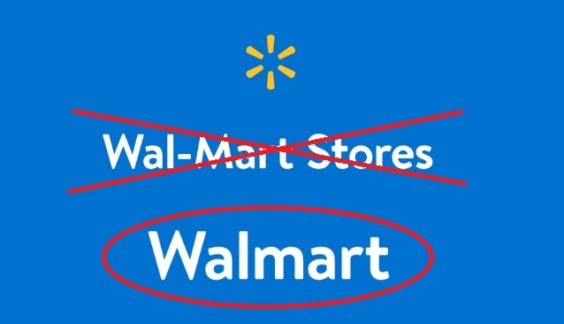
Is it Wal-Mart or Walmart? We finally have an answer, for the most pressing of concerns among bargain shoppers who are also grammarians.
Walmart has officially ditched the hyphen.
“We’re updating our legal name to reflect how customers want to shop,” President & CEO Doug McMillon announced this morning. “Most of us, and I’d guess all our customers, refer to our company as Walmart” – so the company is changing its corporate name from Wal-Mart Stores, Inc., to Walmart Inc., removing both the hyphen and the capitalized M.
That’s actually how the very first Walmart store was branded. But a few years later, the company chose to incorporate as Wal-Mart, setting off decades of inconsistency.
The name change won’t affect anything in stores, which are already branded as Walmart. But it will certainly simplify matters when you write or read about the company. News articles tend to go back and forth between the two stylizations, depending on whether they’re referring to the company (Wal-Mart) or the company’s stores (Walmart).
So Walmart has finally eliminated the ambiguity. Now you can breathe a sigh of relief.
There are other companies that sticklers might hope would now follow suit. Because Walmart isn’t the only retailer that has a different corporate name than the sign out in front of the store.
There’s H-E-B, the grocery chain based in Texas, which eliminates the hyphens in its corporate name, the “HEB Grocery Company”. Aldi insists on branding its stores with all capital letters (ALDI), and usually refers to its company that way too, though most major news outlets refuse to play along and refer to the company using standard upper-lower case.
The products on these retailers’ shelves are also not immune to corporate-name confusion. The Kellogg Company adds an apostrophe “s” to its corporate logo, and is therefore frequently misidentified as Kellogg’s. But the possessive form technically refers to products offered by Kellogg, and not to the company itself.
Branching out from the grocery store, the Northeastern restaurant chain Friendly’s also once struggled with a possessive problem. The chain was founded as “Friendly” back in the 1930’s, but most patrons refused to call it that, choosing to refer to it as “Friendly’s”. The company finally gave in and renamed itself, adding the apostrophe “s” to its company name and its restaurant signage in 1989.
Just don’t look for Kroger to do the same, as it steadfastly declines to rename itself Kroger’s.
Aside from Walmart’s punctuation and capitalization changes, perhaps the most telling but least noticeable alteration in its company name is the elimination of the word “Stores”. That reflects the company’s shift from a purely physical retailer, to one that wants to emphasize its major online presence. “Changing our corporate name to Walmart is a way of better reflecting our company’s path to win the future of retail,” McMillon said. “What won’t change is that Walmart will be there for customers — saving them money and time and helping make every day just a little bit easier.”
So the next time you go shopping at Walmart, you’ll probably be focused on saving some money. But take a moment to note the retailer’s new name, with its 50% fewer capital letters, and 100% fewer hyphens.
See, even before you’ve purchased anything – the company has given you a big discount already.










